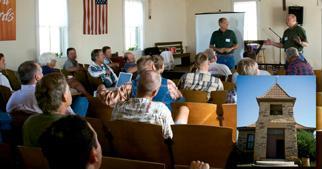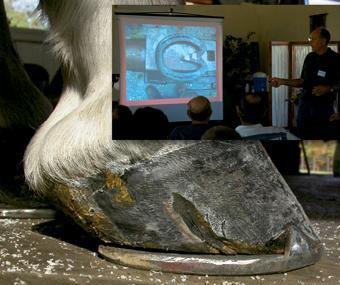Myron McLane sometimes begins a clinic by reminding his audience that he is not just an instructor or clinician — he's a horseshoer.
"I work every day just like you guys," says the International Horseshoeing Hall Of Fame member from Somerset, Mass. "I shoe horses every day."
McLane — sponsored by Mustad Hoofcare Center — traveled with his wife, Pat, to Wagon Mound Ranch Supply in Solano, N.M., for the supplier's annual clinic, where he shared his thoughts with an avid group of listeners.
Time-Tested Methods
McLane says his shoeing techniques — learned from others as well as developed on his own — are time-tested. They have worked consistently for him for years, and he hopes that other farriers will have the same success with them that he has had.
McLane strongly advises that horseshoers learn the anatomy of the leg and hoof, no matter what their particular business requires of them.
"Without knowing anatomy, you can't work on horses," he says. "Even on an ordinary, sound trail horse, if you don't know the anatomy, you can't work on the foot. There's no way you can do a proper job."
Most horseshoers think of frog support when they think of McLane, an association that he is proud of. "Frog support is what I'm all about when it comes to lameness. I think that heart bars, next to regular horseshoes, are the most important shoes," says McLane.
He explains that frog support may be used for any lameness, not only the most crippling sorts that most farriers think of when frog support comes to mind. "Heart bars can be used for underrun heels, laminitis, road founder, mechanical founder, hoof wall avulsions, white line disease and pedal osteitis," he says.
McLlane says he always credits his good friend Burney Chapman for teaching him as well as others about heart bar shoes and their use.
"Burney is the reason heart bars are in use today," he says of the late Lubbock, Texas, farrier. "I am only continuing to teach their use to others."
Many horseshoers believe that McLane builds all of his heart bars by hand, but he actually makes nearly all of them from keg shoes. While he does build some from scratch, he says 99% start out as keg shoes that he puts frog plates in. He builds large quantities of frog plates at a time and keeps them on hand to speed the process of making heart bars.
"You don't have to be a contest horseshoer to make heart bar shoes," he says, "but you do have to have access to a welder."
Make And Fit Them Right
Even though McLane is a staunch believer in heart bars, he stresses that if the shoes are not made correctly or fitted properly, you're probably better off not putting them on. Knowing the exact location of the coffin bone and the circumflex artery is critical in the placement of the frog support. With an improper fit, the circumflex artery may be compromised, shutting off the blood supply.
"Any time you want to kill something, just shut off the blood supply," he says. "But we don't do that. We're not in the killing business, we're in the fixing business."
He does not advise using any sort of wide-web shoe on a foundered horse, whether with a heart bar or not, because the coffin bone can rotate enough to hit the shoe. "A wide-webbed shoe is not what you want on a foundered horse," he says.
McLane tells of a foundered horse that came to him wearing Natural Balance shoes with impression material under a pad.
"They had the right idea with frog support, but the web of that shoe is too wide and it was right over the artery," he recalls. "The impression material as frog support was inadequate and the coffin bone came down and compressed that artery between the bone and the shoe. The horse abscessed terribly."
He believes that specific frog support is better than frog and sole support.
Most horseshoers agree that the tip of the heart-bar should be underneath the extensor process, and McLane stresses the importance of placing it exactly there. If it is too far forward, he says, it may compromise the artery.
"If it is too far back you lose all your leverage and may cause rotation," he says, advising, "Cover as much frog as you can, but don't get over and cause sole pressure."
Danger Of "Killer Shoes"
McLane has numerous stories of what he calls "killer shoes." These are heartbars that were made or applied so incorrectly that they hurt or killed the horse.
Some of the shoes had frog plates that were too long or too short. Others caused sole pressure. One pair of shoes actually had a frog plate that was built around the frog, never touching it, but resting on the sole.
McLane recalls another farrier saying he adjusted his heart bars by sliding a matchbook cover underneath the bar.
"It has to be touching to do its job," he says. "There has always been a certain percentage of farriers who can see all this and understand it, but the rest make the killer shoes."
Another piece of anatomy that McLane believes is an integral part of horseshoeing is the coronary artery. He explains that the coronary artery causes all hoof growth and that the main thickness of the foot goes from the ground to the coronary artery, not to the hairline. The coronary artery must be in good shape for the hoof to grow properly.
"In foundered horses, the hoof wall jams at the toe and slows the blood flow," he says. "That is what causes the heels to grow and not the toe. Heart bars relieve weight from the hoof wall, and if you relieve weight from the hoof wall, you increase blood flow in the coronary artery."
Use With Quarter Cracks
He also explains that if a horse stands with more weight on one side of his foot than the other, blood flow will be slower on the weighted side, slowing down the growth on that side. When a quarter crack is floated, the coronary artery will cause that portion of the hoof to grow faster.
Quarter cracks are often a difficult and discouraging problem for horseshoers, but McLane says you can enjoy a high success rate with heart bars along with floating and debriding the crack.
"Most horses have quarter cracks because of us," he says. "We don't trim the foot properly, so it's from imbalance to the hoof capsule. For the most part, they're man-made."
Short-shoeing can cause cracks, he says, when the foot blows out at the heel of the shoe. Cracks can also results from traumatic injuries, such as racetrack crashes. McLane advises that horseshoers get weight off the crack, apply heart bars and then debride the crack.
Any damaged hoof, he says, should be cleaned away as high as possible without causing the horse to bleed.
"There's no sense debriding up to where it's going to bleed," he says. "If you shoe a horse this way you can fix him without any patches."
McLane has been questioned many times about dirt or debris filling the space under the floated section. He claims this is not a factor, that even when filled with dirt, the unweighted section will not bear as much weight as the rest of the hoof.
"Many times the unweighted section will settle down because it's been jammed up for so long," he says. "It still won't bear as much weight as the weighted section. I've done hundreds of these and it's never been a factor."
Dealing With Road Founder
McLane says road or mechanical founder is prevalent in draft horses because of their weight. There is no problem when a shod draft horse — even one wearing calks — is used in soft ground where the shoe will sink down.
"The minute that horse has to go out on the road all that weight comes down on that foot and pushes the coffin bone down," he says. "The laminae are not strong enough, so they mechanically tear."
While all types of horses are susceptible to road founder, he says it is more common in low-heeled horses. Shoes — especially wedged shoes and calked shoes — cause the problem. McLane says that barefoot horses will not road founder because the frog is in contact with the ground.
McLane says caudal heel syndrome is often misdiagnosed as navicular disease. He says he has seen only a few horses that actually had navicular disease.
"It is my opinion that you can't shoe a navicular horse (so that it will be) sound," he says. "You can accommodate him, but you can't make him sound."
With caudal heel syndrome, however, the pain is located from the middle of the foot back and can be alleviated completely with frog support.
"When you put heart bars on, it supports the coffin bone and alleviates the compression and pain," he says. "The frog support keeps that coffin bone from coming down and touching the sole."
Caudal heel syndrome, he's found, is common in horses with a broken-back axis — where the three phalanx bones are not aligned.
Prolapsed frogs and low heels will also benefit from heart bars, says McLane. He says frog support won't get a horse to grow more heel than he was born with, but will let him grow back whatever may have been lost or crushed.
Full-Support Pads
Most horseshoers are familiar with Myron McLane Full Support Pads. McLane says he first thought of the pads in the early '80s, when he and Chapman were in a motel room after speaking together at a clinic.
Heart bars were just being reintroduced then, and many farriers had difficulty understanding the concept and application.
"I said to Burney, we did this clinic today with 165 people and maybe three of them are going to be able to go home and make these shoes. If we could come up with something that they could just take home and get frog support without having to make the shoes that would be fantastic," McLane recalls. "Burney said, 'You're right, McLane, you need to make something.'"
Many years later, McLane woke up at 3 a.m. with the idea of using plastic. He knew that it would work if the plastic touched the ground to provide the frog support. So, he made the ground surface of the frog plate 5/16-inch thick, the same as most shoes, to bring it into contact with the ground.
McLane says the pads provide an easier method to provide frog support than building a heart bar shoe and are also useful for horseshoers who do not have access to a welder or do not have electricity at a particular barn.
McLane does not advise the use of heart bars or Full Support Pads if the foot is too rotten or thrushy. "The only thing you can do is explain it to the client," he says. Clients should move the horse to a clean, dry stall until the hoof dries out enough to shoe. If this is not an option, treatment may be necessary.
"Pack it (the hoof) with sugardine and bandage it," he suggests. "The sugar will dry out the foot and make it harder."
Remember, It's A Shoe
McLane is constantly asked when a horse will be sound enough to travel without heart bars. Some horses, he says, require heart bars for the rest of their lives. That is not necessarily a bad thing.
"If a horse is sound in these, you can use him for anything that you want to," he says. "People think of a heart bar as some sort of therapeutic device, but it's a horseshoe."









Post a comment
Report Abusive Comment